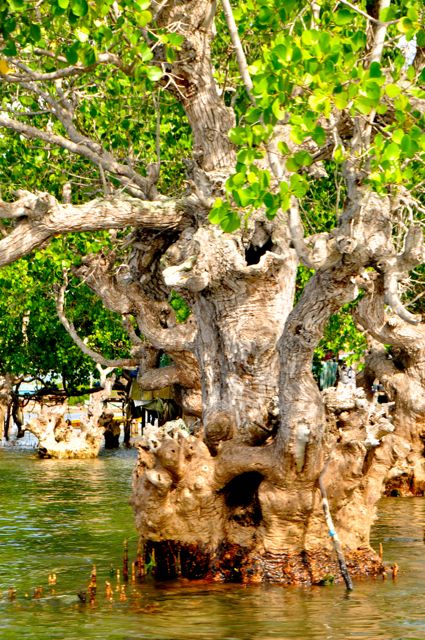I just want to share one of the many facets of the Layag-Layag Community!
First, and foremost, the Layag-Layag Village is a Mangrove community!
The place is just off Barangay Talon-Talon, Zamboanga City, which is about 4-5 km from the City center and about another 10 to 15 minutes by boat!
On the way to Layag-Layag!
 |
| Mangrove rehabilitation: planting new mangrove plants |
Exactly as my friend, Harry was afraid of, the mud in the Mangroves are so thick with litter and bacteria, including Vibrio!
Mangroves also come in different size and shape... and its age also adds character to the tree!
The roots also vary like the peg roots, which look like sticks and the stilt roots, which look like branches directed to the floor.
 |
| older mangroves |
 |
| Pneumatophores or peg roots penetrate the sand surrounding a mangrove tree. |
Here we are now passing through the mangroves as we leave the village...
 |
| Photo credit: Michelle Lim |
This is the first time for me to appreciate the beauty of the mangroves up close.
I want to share some tips on Protecting Mangroves: http://www.dpi.nsw.gov.au/__data/assets/pdf_file/0020/236234/mangroves.pdf
Some simple ways to help protect mangroves are:
• fence along the intertidal zone and prevent stock access to mangrove areas,
• design riverfront structures such as jetties or boat ramps to avoid or minimise impacts to mangroves,
• avoid walking, riding or driving through mangrove areas at low tide,
• dispose of rubbish, oils and chemicals in the correct manner
P.S. The captions I have placed come from this website: http://www.oceanicresearch.org/education/wonders/mangroves.htm







The more I read your blog, the more I want to go to Zamboanga. Is this tour open to everyone?
ReplyDeleteWe have to ask permission from the Yellow Boat group because they have the access...
ReplyDeleteHonestly, this is AMAZING! Aww. Life and it's wonders. God is indeed great.
ReplyDeleteYou took vivid shots of the water. Very Nice!
ReplyDeleteWaaah! The way towards the layag layag is such an awesome place... though I'm not sure in the dark :( Hahah! Duwag ako sa mga ganyang scene kasi. Good shots btw.
ReplyDeleteSiguro yan yung floating island ni Pi! :) I guess okay lang na maraming bacteria dun, kasi not meant for people yung area. Hope there are more protected mangroves in our seas.
ReplyDeleteI've heard that where there is Mangroves, they usally is also visited by dolphins as it's their food :)
ReplyDeleteSeems to be an enchanting place! I'd love to see this in person!
ReplyDeleteLife is truly amazing. Mangroves are some of those beautiful creations of God that we often take for granted, great that there are rehabilitation that's being made. I enjoyed the photos very much.
ReplyDeletecool place. love to see this one day.
ReplyDeleteWhat an amazing share! It is sad to read about the pollution and how the mangroves survive...
ReplyDeleteEliz
Wow. What a nice place to tour around. Thanks for sharing.
ReplyDeleteThe first time I've ever seen mangroves was during my first ever trip to Cebu on our way to see Lapu-Lapu's statue. I was in awe at its beauty. It really should be saved.
ReplyDelete